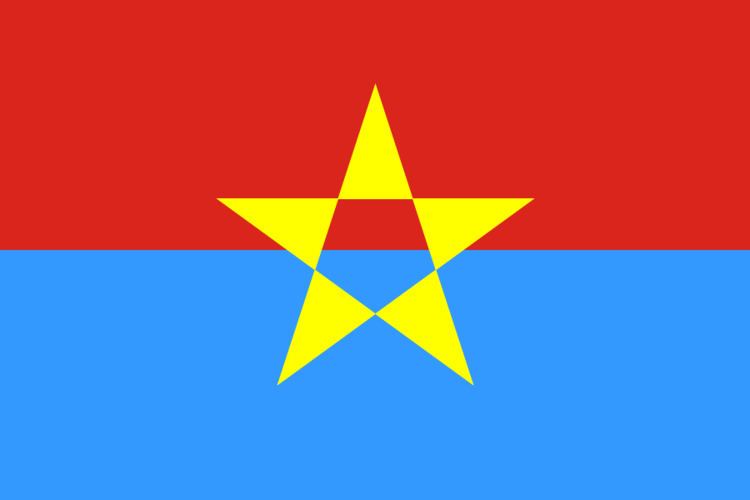Flag Emblem Founded 8 June 1969 Date dissolved July 2, 1976 | Languages Vietnamese Government formed June 8, 1969 Area 173,809 km² | |
 | ||
Religion BuddhismConfucianismTaoism Capitals Lộc Ninh (1969–1975), Ho Chi Minh City (1975–1976) | ||
Provisional revolutionary government of the republic of south vietnam
The Provisional Revolutionary Government of the Republic of South Vietnam, or PRG, was formed on June 8, 1969, as an underground government opposed to the South Vietnamese government of President Nguyễn Văn Thiệu. Delegates of the National Liberation Front (the Viet Cong), as well as several smaller groups, participated in its creation.
Contents
- Provisional revolutionary government of the republic of south vietnam
- History
- National anthem
- Origin of name Provisional Revolutionary Government
- References
The PRG was recognized as the government of South Vietnam by most communist states. It signed the 1973 Paris Peace Treaty as a separate party. It became the provisional government of South Vietnam following the military defeat of the Army of the Republic of Vietnam on April 30, 1975. On July 2, 1976, the PRG and North Vietnam merged to form the Socialist Republic of Vietnam.
History
Predating the PRG was the Alliance of National, Democratic, and Peace Forces made up of anti-government forces and headed by Trinh Dinh Thao. The Alliance were a collection of individuals who wanted a new South Vietnamese government but disagreed with the ever-present Northern Communist presence.
There had been talk of setting up an Alliance as early as 1966, but the South Vietnamese Intelligence had arrested an anti-government organizer, Ba Tra. Ba Tra gave the South Vietnamese government extensive information on anti-government forces working in the city. This setback was compounded by his identification of one of the key cadre in the financial division.
Under torture, Ba Tra identified more figures in the underground. These were then rounded up. By 1967, the entire Saigon organization had been sent further underground. The Tet Offensive during 1968 triggered a wave of oppression, forcing many people into the jungle. These people – businessmen, middle class, doctors and other professionals – started The Alliance.
The then-new American president, Richard Nixon, started a process of Vietnamization to allow the American to withdraw from Vietnam. One of the tenets of Vietnamization was responsible government in South Vietnam. To prevent the Americans from installing their own government, a conference was held on June 6–8, 1969, off Route 22 in Cambodia's Fishhook area.
The Alliance as well as other groups met and formed the Provisional Revolutionary Government on June 8, 1969. According to Justice Minister Trương Như Tảng, the new group's main purpose was to help the Vietcong "acquire a new international stature."
There were delegates from the NLF, the Alliance of National, Democratic and Peace Forces, the People's Revolutionary Party (the South Vietnamese communist party) and "the usual assortment of mass organizations, ethnic groups, and geopolitical regions." "South Vietnam is independent, democratic, peaceful, and neutral", according to one banner displayed prominently at the convention.
The PRG reflected a number of nationalist, anti-imperialist and communist political viewpoints, including those of the Vietnam Workers Party (the North Vietnamese communist party). Following the military and political results of the 1968 Tet Offensive and related military offensives in the South, in which the Vietcong suffered serious military losses, the PRG was envisioned as a political counter-force that could influence international public opinion in support of reunification and in opposition to the United States and the Republic of Vietnam.
The declared purpose of the PRG was to provide a formal NLF governmental structure and enhance its claim of representing "the Southern people". Included in this strategy was the pursuit of a negotiated settlement to the war leading to reunification, organized during the initial phase of Vietnamization.
During the period 1969–70, most of the PRG's cabinet ministries operated near the Cambodia border. Starting on March 29 to late April 1970, the South Vietnamese army and Cambodian government forced the PRG to flee deep into Cambodia. The stressful escape caused many of the PRG officials (such as Trương Như Tạng) to need extensive medical furloughs. After Trương Như Tạng returned, he noticed that new cadres from the north were causing problems for the non-communist members of the PRG. One member in particular, Ba Cap, harshly denounced most of the PRG as bourgeois. Tạng complained to the higher members of the North Vietnamese government, but was rebuffed. Tạng later saw this as the point when the PRG turned from being an independent South Vietnam-based alternative government to being a mouthpiece for Northern Vietnamese communists.
The central bodies of the PRG functioned as a government in exile. The PRG maintained diplomatic relations with many countries of the Non-Aligned Movement, such as Algeria, as well as with the Soviet Union and the People's Republic of China.
After the surrender of Saigon on April 30, 1975, the PRG assumed power in the South and subsequently participated in the political reunification of the country.
National anthem
The national anthem of the Government was To Liberate the South (Vietnamese: Giải phóng miền Nam). The song was written in 1961 by Lưu Hữu Phước (1921–1989) and adopted at that time as the anthem of the National Front for the Liberation of Vietnam.
Origin of name "Provisional Revolutionary Government"
Since the Revolutions of 1848, the term provisional government has referred to liberal government created to prepare for democratic elections that would establish government on a permanent basis. Bolshevik leader Vladimir Lenin defined a "provisional revolutionary government" as one that appeals to the people, but where workers and peasants "take the initiative." A PRG would, "convene on the basis of universal, equal and direct suffrage by secret ballot a constituent assembly," Lenin added. Algeria's National Liberation Front, a model for revolutionaries in the 1960s and 1970s, created a Provisional Government of the Algerian Republic in 1958. (This name is a variation of Provisional Government of the French Republic (1944–1946).)
